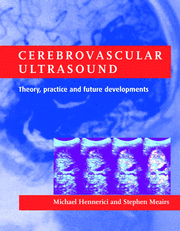Book contents
- Frontmatter
- Dedication
- Contents
- List of contributors
- Preface
- PART I ULTRASOUND PHYSICS, TECHNOLOGY AND HEMODYNAMICS
- PART II CLINICAL CEREBROVASCULAR ULTRASOUND
- (i) Atherosclerosis: pathogenesis, early assessment and follow-up with ultrasound
- (ii) Extracranial cerebrovascular applications
- (iii) Intracranial cerebrovascular applications
- 18 Transcranial Doppler ultrasonography and vasospasm after subarachnoid hemorrhage
- 19 Intracranial cerebral artery stenosis and occlusion
- 20 Arteriovenous malformations
- 21 High intensity transient signals
- 22 Transcranial Doppler monitoring during carotid endarterectomy
- 23 Cerebral vasoreactivity
- 24 Intracranial venous diseases: the role of ultrasound
- PART III NEW AND FUTURE DEVELOPMENTS
- Index
18 - Transcranial Doppler ultrasonography and vasospasm after subarachnoid hemorrhage
from (iii) - Intracranial cerebrovascular applications
Published online by Cambridge University Press: 05 July 2014
- Frontmatter
- Dedication
- Contents
- List of contributors
- Preface
- PART I ULTRASOUND PHYSICS, TECHNOLOGY AND HEMODYNAMICS
- PART II CLINICAL CEREBROVASCULAR ULTRASOUND
- (i) Atherosclerosis: pathogenesis, early assessment and follow-up with ultrasound
- (ii) Extracranial cerebrovascular applications
- (iii) Intracranial cerebrovascular applications
- 18 Transcranial Doppler ultrasonography and vasospasm after subarachnoid hemorrhage
- 19 Intracranial cerebral artery stenosis and occlusion
- 20 Arteriovenous malformations
- 21 High intensity transient signals
- 22 Transcranial Doppler monitoring during carotid endarterectomy
- 23 Cerebral vasoreactivity
- 24 Intracranial venous diseases: the role of ultrasound
- PART III NEW AND FUTURE DEVELOPMENTS
- Index
Summary
Introduction
Vasospasm following subarachnoid hemorrhage (SAH) typically affects the large basal cerebral arteries and can lead to delayed ischemic neurological deficits several days after the bleeding. The diagnosis of cerebral vasospasm is confirmed by demonstration of segmental narrowing of the involved vessels on angiography. However, angiography is invasive and inappropriate for frequent monitoring of SAH patients. Since its introduction in 1982 by Aaslid et al. (1982), transcranial Doppler (TCD) ultrasonography has matured to a useful and reliable technique to detect cerebral vasospasm after SAH. The non-invasive character of TCD ultrasonography and its convenient use in the intensive care unit make it particularly well suited for serial monitoring of patients at risk to develop vasospasm. In addition, TCD ultrasonography can give useful information on the effects of prophylactic and therapeutic measures against vasospasm such as vasodilators, neuroprotectants, induced hypertension/hypervolemia, or transluminal angioplasty.
Although 15 years of clinical use have established the role of TCD ultrasonography in decision-making and clinical management of patients with SAH, there are still controversies about its real contribution in the identification of those patients who are at risk of ischemic neurological deficit. TCD ultrasounds actually measure blood flow velocities and give only indirect information on vessel calibre and cerebral blood flow (CBF). This fact is associated with methodological assumptions and limitations. The information gained from TCD findings on cerebral hemodynamics has to be interpreted in relation to the clinical situation of each patient.
- Type
- Chapter
- Information
- Cerebrovascular UltrasoundTheory, Practice and Future Developments, pp. 261 - 270Publisher: Cambridge University PressPrint publication year: 2001



